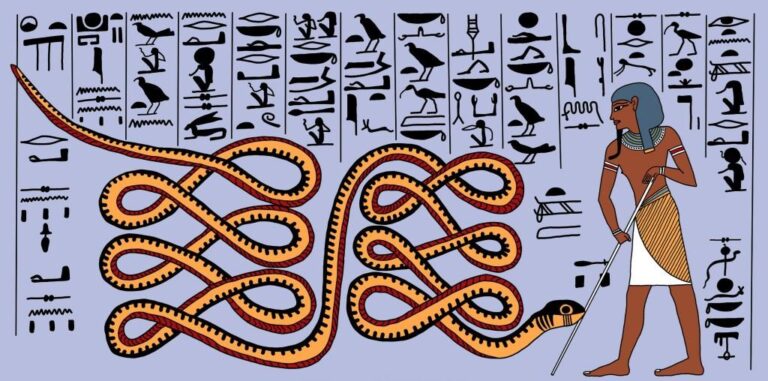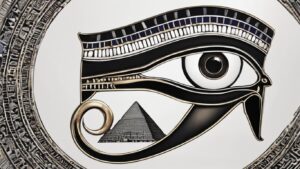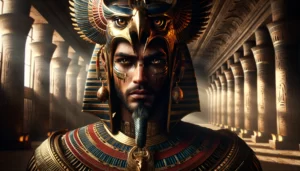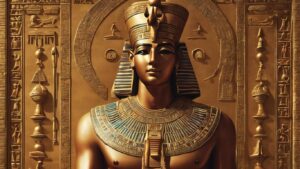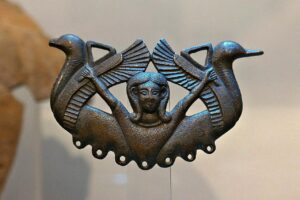Table of Contents
Key aspects and associations with Apophis:
Chaos and Destruction: Apophis represents chaos and is considered a force of destruction in Egyptian mythology. The serpent was believed to threaten the order and harmony established by the gods.
Nightly Battles: According to Egyptian mythology, Apophis posed a nightly threat to the sun god Ra as he traveled through the underworld during the night. The serpent attempted to devour Ra and prevent the sun from rising again.
Role in the Duat: The Duat is the realm of the underworld in Egyptian mythology. Apophis was thought to reside in the waters of the underworld and posed a constant challenge to the souls of the deceased as they journeyed through this realm.
Protective Rituals: Ancient Egyptians believed in the necessity of protective rituals and spells to thwart Apophis’s attacks on Ra. These rituals were often performed during nightly ceremonies to ensure the sun’s successful journey through the underworld.
Cosmic Symbolism: The battle between Apophis and Ra was seen as a cosmic struggle between order and chaos, with Ra representing the sun and the forces of life, while Apophis embodied darkness and destruction.
Iconography: Apophis is typically depicted as a colossal serpent with menacing features. In some representations, he is shown being pierced by Ra or other protective deities.
Mythological Significance: The mythology surrounding Apophis emphasizes the Egyptians’ concern with maintaining cosmic order and the cyclical nature of the sun’s journey. The nightly battles with Apophis were integral to the Egyptian understanding of the afterlife and the renewal of life each day.
While Apophis is a symbol of chaos and threat in Egyptian mythology, it’s important to note that he was not worshiped or revered by the ancient Egyptians. Instead, rituals and protective measures were employed to ensure the defeat of Apophis and the continuation of cosmic order.
Appearance

The appearance of Apophis, the serpent deity in ancient Egyptian mythology, is often depicted in various forms of Egyptian art. Some common features associated with the appearance of Apophis:
Serpent Form: Apophis is typically represented as a giant serpent or snake. The serpent’s coiled and sinuous form symbolizes chaos and is a common motif in Egyptian mythology.
Gigantic Size: In artistic representations, Apophis is often depicted as an enormous serpent, emphasizing his formidable and threatening nature. This emphasizes the cosmic scale of the battle between Apophis and the sun god Ra.
Dark and Menacing Features: The serpent is portrayed with dark and menacing features, emphasizing its association with chaos and destruction. Artists would use visual cues such as sharp fangs and a menacing expression to convey the threatening nature of Apophis.
Sun Disk and Boat: In some depictions, Apophis is shown approaching the sun god Ra, who travels through the underworld in a boat. Apophis is often depicted attempting to devour the sun or disrupt its journey, emphasizing the nightly battle between order and chaos.
Hieroglyphic Representations: Apophis is sometimes represented in hieroglyphic inscriptions, where the serpent’s image may be combined with other symbols and figures to convey its mythological significance.
Symbolic Defeat: Some representations depict Apophis being vanquished or pierced by Ra or other protective deities. These scenes symbolize the triumph of order over chaos and the sun’s successful journey through the underworld.
Artistic representations of Apophis could vary, and the symbolism associated with this serpent deity played a significant role in conveying the ancient Egyptian understanding of cosmic order, the cyclical nature of the sun’s journey, and the perpetual struggle against chaos.
Family

In ancient Egyptian mythology, Apophis (or Apep) is not typically depicted as part of a divine family in the way that many other Egyptian deities are. Instead, Apophis is often considered a force of chaos and destruction, a cosmic antagonist rather than a deity with familial connections.
The primary relationships and genealogies in Egyptian mythology usually involve gods and goddesses associated with creation, order, and various aspects of nature. Apophis, as a representation of chaos, is more commonly depicted in opposition to these deities, particularly in the context of the nightly battles with Ra, the sun god, as Ra travels through the underworld.
In essence, Apophis is not portrayed as having a divine family tree in the traditional sense, but rather as a malevolent force with the sole purpose of disrupting the cosmic order and threatening the sun’s journey through the night sky.
Origin
The origin of Apophis, the serpent deity in ancient Egyptian mythology, is deeply rooted in the religious beliefs and cosmology of ancient Egypt. Apophis is associated with chaos and represents a force that opposes order and threatens cosmic harmony. The specifics of Apophis’ origin are not as detailed or mythically elaborated upon as the stories surrounding more prominent gods, but some aspects can be discussed:
Primordial Chaos: Apophis is often linked to the concept of primordial chaos. In the Egyptian cosmogony, the universe emerged from a state of formless chaos. Apophis embodies this chaotic force that seeks to disrupt the order established by the gods.
Ongoing Existence: Apophis is sometimes described as having existed from the earliest times, reflecting the enduring nature of chaos in the Egyptian worldview. The idea is that chaos is not a one-time event but an ever-present force that the gods must continually contend with.
Symbolic Representation: Apophis is more of a symbolic representation of chaos and opposition rather than a deity with a detailed mythological narrative. The nightly battles between Apophis and Ra, where the serpent attempts to thwart the sun’s journey, are symbolic of the perpetual struggle between order and chaos.
Absence of Creation Story: Unlike some other major Egyptian deities, Apophis does not have a creation myth or a detailed narrative explaining his origin. Instead, he serves a specific role in the cosmological and religious framework, representing the ever-present threat to cosmic order.
Apophis’ origin is intricately tied to the Egyptian cosmological understanding of the universe emerging from primordial chaos. Apophis personifies the ongoing force of chaos that challenges the gods and the order they establish. The focus on Apophis is more on its symbolic role and the continuous cosmic struggle it represents rather than a detailed narrative of its own creation.
History
The “history” of Apophis in ancient Egyptian mythology is more accurately described as a recurring theme rather than a chronological account. Apophis, also known as Apep, represents a force of chaos and is prominently featured in the religious beliefs and practices of ancient Egypt. Here are key points related to the historical and mythological aspects of Apophis:
Symbolic Battles: Apophis is primarily known for its symbolic battles with Ra, the sun god, during the nightly journey through the underworld. These battles are more metaphysical and represent the ongoing struggle between order and chaos.
Cyclical Nature: The encounters between Apophis and Ra are part of a cyclical and nightly occurrence in Egyptian cosmology. Each night, Ra travels through the underworld, and the serpent attempts to obstruct his journey, symbolizing the eternal struggle between light and darkness.
Protective Rituals: The ancient Egyptians believed in the importance of protective rituals and spells to safeguard Ra from Apophis’ threat. These rituals were performed regularly during nightly ceremonies to ensure the sun’s successful rebirth each day.
Cosmic Significance: The battles with Apophis were considered of great cosmic significance. The Egyptians saw the sun’s journey as essential for the renewal of life, and thwarting Apophis was crucial for maintaining cosmic order and the cycles of nature.
Mythological Texts: References to Apophis can be found in various ancient Egyptian texts, including funerary texts, hymns, and religious inscriptions. These texts emphasize the importance of protective measures to ensure the well-being of the deceased in the afterlife.
Cultural Impact: The concept of Apophis had a significant impact on Egyptian religious thought. It reinforced the idea that cosmic order and the regular cycles of nature required continuous effort and vigilance from both the gods and humans.
Role in the Duat: Apophis is often associated with the Duat, the realm of the dead in Egyptian mythology. The serpent’s presence in the underworld adds a layer of complexity to the journey of the deceased through the afterlife.
While Apophis does not have a detailed personal history or narrative in the way some deities do, its role as a symbol of chaos and the ongoing struggle with Ra is deeply woven into the religious and cosmological fabric of ancient Egyptian beliefs. The historical understanding of Apophis comes from interpretations of religious texts, artistic representations, and the cultural practices of ancient Egypt.
Apophis godness and meteor relation
The connection between the ancient Egyptian deity Apophis and the near-Earth asteroid named Apophis is primarily coincidental and rooted in the choice of the name rather than any inherent relationship between the mythological figure and the celestial object. Let’s explore both aspects:
Apophis in Egyptian Mythology:
Apophis, also known as Apep, is a serpent deity in ancient Egyptian mythology associated with chaos and destruction. It is not considered a benevolent god but rather a force that opposes cosmic order, particularly in its nightly battles with Ra, the sun god, during the journey through the underworld.
Apophis the Near-Earth Asteroid:
The near-Earth asteroid named Apophis was discovered in 2004 and is officially designated as 99942 Apophis. The asteroid garnered attention due to initial calculations suggesting a potential impact with Earth, leading to concerns about its potential hazard. Subsequent observations have refined our understanding of its orbit, and the current consensus is that Apophis poses no significant impact risk in the foreseeable future.
The choice to name the asteroid Apophis likely stems from the asteroid’s potential threat, drawing an analogy between the destructive force of the asteroid and the chaotic nature of the serpent deity in Egyptian mythology. However, it’s important to note that the asteroid itself is not considered a god or deity.
